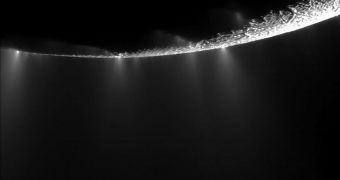The NASA spacecraft Cassini has completed its latest distant flyby of Enceladus, one of Saturn's most interesting moons, and has just finished sending back the first raw and uncalibrated images.
Although the fully-validated and calibrated photos will only be made available through the NASA Planetary Data System in 2011, experts can still use the raw photographs to look closely at the features.
Located at the moon's south pole, the landscape features captured the eyes of astronomers after Cassini discovered that plumes of ice, water vapors and organic material are being ejected through them.
The material is thought to contribute to the development of one of Saturn's rings, and so experts immediately became curious as to the forces driving the expulsion process.
Since then, Cassini has done numerous flybys of Enceladus, and astronomers operating it managed to capture a wealth of images detailing the “tiger stripes” and their plumes.
The new flight was prompted by the fact that the winter season on the Saturnine moon is darkening its south pole. This allows the use of a highly-sensitive infrared imager.
The Composite Infrared Spectrometer (CIRS) was the primary scientific payload on Cassini used for the new investigation.
The remote sensing instrument is very sensitive to infrared wavelengths, and it can analyze them to extract data on the temperatures, thermal properties, and compositions of its targets.
The new flyby was meant to take Cassini no less than 2,500 kilometers (1,600 miles) above the moon's surface, as experts managing the mission wanted to get a bird's eye view of the tiger stripes.
The group, which is based at the NASA Jet Propulsion Laboratory (JPL), in Pasadena, California, says that it will take some time until they can turn the new CIRS readings into viable temperature maps of the landscape features.
One of the things that makes Enceladus stand out from the crowd of Saturnine moons is the fact that astronomers believe it may house a liquid ocean.
Naturally, liquid water cannot endure in the frigid temperatures of its surface, but the experts say that it may be buried several kilometers, under a thick ice crust.
Discovering the ocean, and the processes that make it spew out matter into space – so as to fuel Saturn's E ring – is one of the main goals for Cassini.

 14 DAY TRIAL //
14 DAY TRIAL //